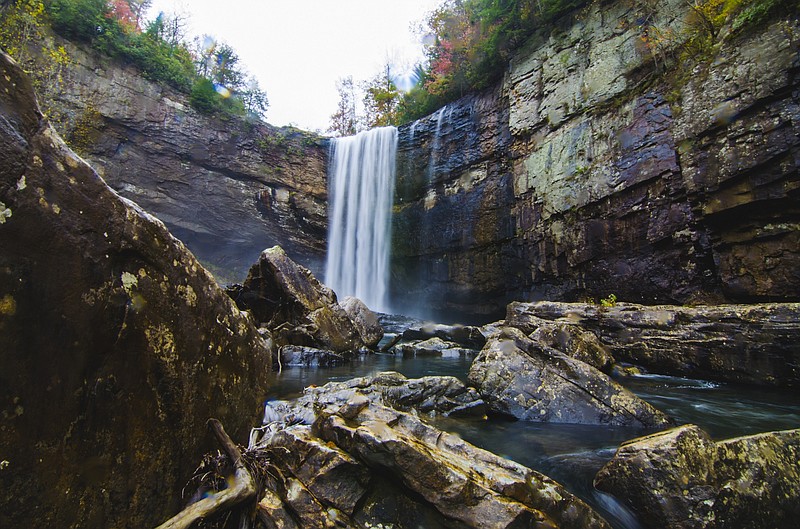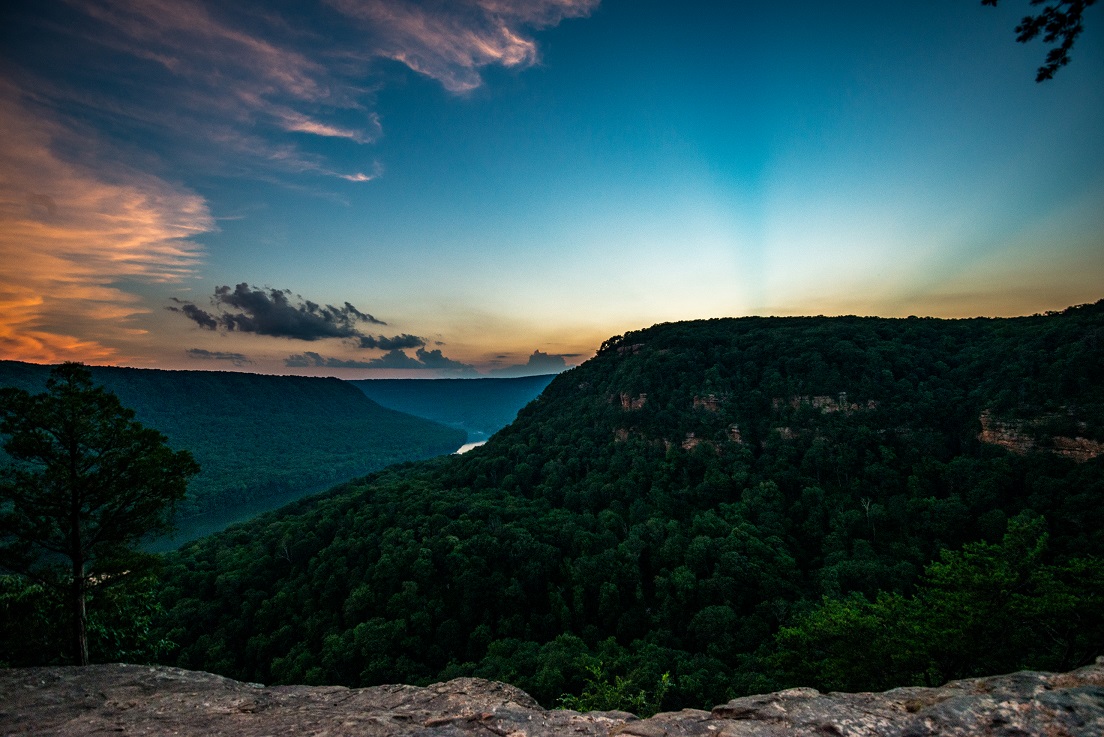Conservation easement
A voluntarily donated (or occasionally sold) legally binding real estate agreement to limit or ban certain uses and development on a piece of property in perpetuity. Each easement is individually tailored to best suit the needs of the landowner and either a public or private agency. Easement agreements can range from limited-development agreements or a guarantee not to subdivide, to complete forfeiture of soil, mineral and timber rights. This guarantees that even if a property is sold or inherited, all future landowners must adhere to the requirements of the easement, protecting the property forever.
When Robert M. Davenport lay on his deathbed following an unexpectedly short battle with a rapidly progressing cancer, he thought about the land that would outlast him. In particular, he thought of the waterfall, the lake and the natural beauty of the area surrounding what we now identify as the core of the Lula Lake Land Trust property.
The land was treated as no more than a garbage dump before Davenport purchased it parcel by parcel in the 1960s and began to clean it up with the help of his family. Slowly and surely, he restored it to its former glory. He toyed with the idea of selling it or developing it, but was never able to find a way to do so without taking away from the majesty of the waterfall and the deep blue lake.
"I remember cleaning out those caves with my father when I was younger," his son, Bobby Davenport, says. "There was certainly different activity than what the Girl Scouts do out there nowadays. I cleaned out a lot of needles - the motorcycle gang that lived there must have had a lot of diabetics, that's all I'll say about that."
Robert's children signed an amended will to donate the land in 1994, and the family remains the largest donors to the Lula Lake Trust to this day, with 770 acres donated and another 440 acres protected under a conservation easement.
For Bobby, it brought a lifelong passion and career in conservation. "The whole thing just kind of began as the four of us with our dad," he says. "But since then it's grown to a whole universe of contacts. I don't think anyone, including us, ever thought it would grow to be like this.
"Since then, there have been a lot of others inspired and driven by that. That's how big things grow - it starts with a single step."
Single steps such as the Davenports' are not uncommon in the conservation world, says Lookout Mountain Conservancy Director Robyn Carlton.
Prior to Carlton's entrance as director, Dr. Chris Moore took a step similar to the Davenports', purchasing a 400-acre tract of land on Lookout Mountain to preserve it through a conservation easement. Now dubbed Long Branch, the property encompasses a multitude of trails, and sits adjacent to Lula Lake Land Trust's property.
"It wasn't really something I had long thought about doing," Moore says of preserving the land. "It was just that there was this piece of property and it was going to go on the market, and all I could do was imagine some developer with a lot of money coming and putting 300 homes on 400 acres of property and that land just being gone forever."
Rather than letting that happen, Moore created a conservation easement, ensuring the land would be protected eternally. Rather than 300 homes, the most that will ever exist is 20, according to the terms of his easement that the Lookout Mountain Conservancy upholds.
"Long Branch itself has not only protected its entire 400 acres, but it's surrounded by Lula Lake Land Trust property, so it's sort of a little jewel in the midst of lots and lots of preserved land," he says. "It's rural, it's wooded, it's got beautiful views. We sit in a little valley looking up at all of these surrounding hills that will just always have those views. It creates this contemplative place that has a great sense of living in the out of doors."
And that's the funny thing about land preservation, says Joel Houser, The Land Trust for Tennessee's southeastern conservation director. "The funny thing about conservation is you don't know you need it until you lose it."
With rapid growth spreading across the Chattanooga area, conservation efforts have never been more important.
"It's hard to really grasp how threatened the land around us really is," Houser says.
For instance, from 2007 to 2012, Tennessee alone suffered a loss of of 3,000 farms on nearly 600,000 acres of farmland, he says. The loss isn't just of the land itself, but the fertile soil. "There's a reason we joke that asphalt is the last great crop," says Houser. " What we can all agree on is the goal of conservation is to make humans' lives better."
As Chattanooga's population climbs to 200,000, bringing development across the city and its surrounding mountainscape with no signs of slowing down, how public and private entities approach conservation has to adapt, says Tennessee River Gorge Trust Director Rick Huffines.
"It's kind of like a marriage," he says of conservation relationships forged by entering into easements with private citizens or other public conservation groups. "The very important factor to me in this role as executive director is to work in a collaborative approach and work to make sure that no matter who is in charge of these groups in the future, there is a system in place to protect this land."
Sometimes, he adds, the relationship is twofold, such as the case with attorney Harvey Cameron and the popular climbing destination Castle Rock.
Cameron and his longtime friend, the late Sam "Bud" Werner, owned the Jasper, Tennessee, property for more than 30 years, allowing the Southeastern Climbers Coalition to maintain and utilize the space. "It's absolutely pristine," Cameron says, speaking of the space's awe-inspiring view from the top of the rock.
When Werner passed away, he willed his portion of the property to be conserved, protected in perpetuity from development. Cameron followed suit, and so Castle Rock was donated to the River Gorge Trust.
But rather than guard the popular property for the Gorge, Huffines created a conservation easement for Castle Rock which the organization then gave to The Land Trust for Tennessee. In turn, management rights were given to the SCC to solidify both Castle Rock's place in the climbing world and as a valuable piece of local landscape.
The move created layers of accountability, ensuring the land will continue to be protected for public enjoyment long after Huffines and Houser are no longer in charge.
"It comes down to, there are certain places like the Gorge that we need to keep set aside, that are special, that are unlike anywhere else you would find in the eastern United States," Huffines says. "And I think that these spaces deserve to be protected for the public and the community; these are wild places that need to stay wild."
As long as Moore, Davenport and Cameron are around, they say they'll continue to advocate for others to take steps similar to their own first forays into conserving land. Whether it is for limited development, agriculture, a climber's paradise or simply nothing at all, protected green space is critically important for the future.
"The one thing it always comes back to is, we have to have habitat to survive - every species does. We have to have food, shelter, water and the last one we tend to forget is space," Huffines says. "And space is a finite thing and you don't really realize it until it's gone."
"You can Google how much raw land is lost to development on a daily basis," adds Moore. "We have a population that's growing and people who want to live a certain way, but uncontrolled growth is discouraging. I have my first grandchild now, and I look at her and I want her to grow up and see some of these same landscapes. We have to make sure that land is there - for her and for the future."

